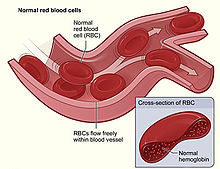| Hemolytic anemia | |
|---|---|
| Other names | Haemolytic anaemia |
 | |
| Figure shows normal red blood cells flowing freely in a blood vessel. The inset image shows a cross-section of a normal red blood cell with normal hemoglobin.[1] | |
| Specialty | Hematology |
| Causes | Hemolysis |
Hemolytic anemia or haemolytic anaemia is a form of anemia due to hemolysis, the abnormal breakdown of red blood cells (RBCs), either in the blood vessels (intravascular hemolysis) or elsewhere in the human body (extravascular).[2] This most commonly occurs within the spleen, but also can occur in the reticuloendothelial system or mechanically (prosthetic valve damage).[2] Hemolytic anemia accounts for 5% of all existing anemias.[2] It has numerous possible consequences, ranging from general symptoms to life-threatening systemic effects.[2] The general classification of hemolytic anemia is either intrinsic or extrinsic.[3] Treatment depends on the type and cause of the hemolytic anemia.[2]
Symptoms of hemolytic anemia are similar to other forms of anemia (fatigue and shortness of breath), but in addition, the breakdown of red cells leads to jaundice and increases the risk of particular long-term complications, such as gallstones[4] and pulmonary hypertension.[5]
- ^ "Red Blood Cells". US National Library of Medicine. Archived from the original on 2017-01-01.
- ^ a b c d e Capriotti, Theresa (2016). Pathophysiology : introductory concepts and clinical perspectives. Frizzell, Joan Parker. Philadelphia. ISBN 978-0-8036-1571-7. OCLC 900626405.
{{cite book}}: CS1 maint: location missing publisher (link) - ^ Philadelphia, The Children's Hospital of (2014-03-30). "Hemolytic Anemia". chop.edu. Retrieved 2020-02-25.
- ^ Trotman, BW (1991). "Pigment gallstone disease". Gastroenterology Clinics of North America. 20 (1): 111–26. doi:10.1016/S0889-8553(21)00536-7. ISSN 0889-8553. PMID 2022417.
- ^ Machado, Roberto F.; Gladwin, Mark T. (2010). "Pulmonary Hypertension in Hemolytic Disorders". Chest. 137 (6). Elsevier BV: 30S–38S. doi:10.1378/chest.09-3057. ISSN 0012-3692. PMC 2882115. PMID 20522578.